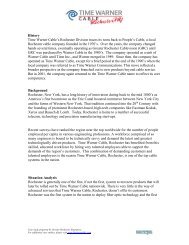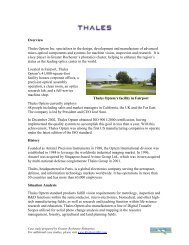OPTICS, IMAGING AND PHOTONICS - Greater Rochester Enterprise
OPTICS, IMAGING AND PHOTONICS - Greater Rochester Enterprise
OPTICS, IMAGING AND PHOTONICS - Greater Rochester Enterprise
Create successful ePaper yourself
Turn your PDF publications into a flip-book with our unique Google optimized e-Paper software.
Lasers reveal the presence of pathogens using new<br />
biomedical optics for smart bandage technology.<br />
Clean room facilities for Microsystems research at RIT.<br />
Satellite image for<br />
specialized analysis<br />
Smart Bandage Technology for the Biotech Industry<br />
Imagine placing an adhesive bandage on a cut and having the bandage tell you immediately that dangerous bacteria has invaded<br />
the wound and you need to seek a doctor’s help. Researchers at the University of <strong>Rochester</strong> have taken the first major step<br />
toward a bandage that will emit different colors, depending on what kind of bacteria may be present in a wound. The<br />
accomplishment is evidence that it’s indeed possible to accurately identify bacteria with a silicon sensor.<br />
ROCHESTER INSTITUTE OF TECHNOLOGY<br />
Microsystems Research<br />
Using a prototype 193-nanometer liquid-immersion “microstepper” tool developed by RIT, optical image resolution at the<br />
smallest-ever level is made possible. As a result, microchips can be produced with optics and light much closer to the ultraviolet<br />
range, making possible the development of smaller, faster and more powerful microchips. Circuits are 10 times smaller and more<br />
affordable than possible from conventional methods. The technology was unveiled at a workshop sponsored by International<br />
SEMATECH in Los Angeles, California in January 2004.<br />
Image Enhancement Technology Brings<br />
Applications for the Security Industry<br />
RIT is developing state-of-the-art image-enhancement technology that will benefit counter-terrorism, border patrol, law<br />
enforcement and medical fields. Using wavelet enhancement, software technology filters out unwanted detail from X-ray, radar<br />
and infrared images, enhancing desired detail in high-resolution images. Potential uses include concealed-weapons detection,<br />
through-the-wall surveillance and tumor detection.<br />
Wildfire Detection<br />
The U.S. Forest Service has the advantage of a new tool that identifies and locates wildfires as small as 8- to 12-inches in<br />
diameter from an altitude of 10,000 feet. Using grant money from NASA, scientists at RIT have created a prototype of this<br />
new remote sensing system for trial by the Forest Service. The project, known as the Wildfire Airborne Sensor Program (WASP),<br />
is being conducted at RIT’s Chester F. Carlson Center for Imaging Science.<br />
Specialized Analysis of Great Lakes Water Quality<br />
Researchers at RIT are taking a close look at the Great Lakes' water quality<br />
using a combination of remote sensing imagery and modeling of lake dynamics.<br />
NASA's Landsat 7 satellite has carried the hard work of a team of RIT imaging<br />
scientists out into space. The satellite has captured high-resolution images<br />
that have allowed for continued research into the Great Lakes.<br />
High-resolution satellite images of<br />
Great Lakes water quality.<br />
2003 R&D 100 AWARD FOR<br />
MEMS-BASED ADAPTIVE <strong>OPTICS</strong> PHOROPTER (MAOP)<br />
David Williams, CEIS principal investigator and professor of brain and cognitive sciences at the UR<br />
9








